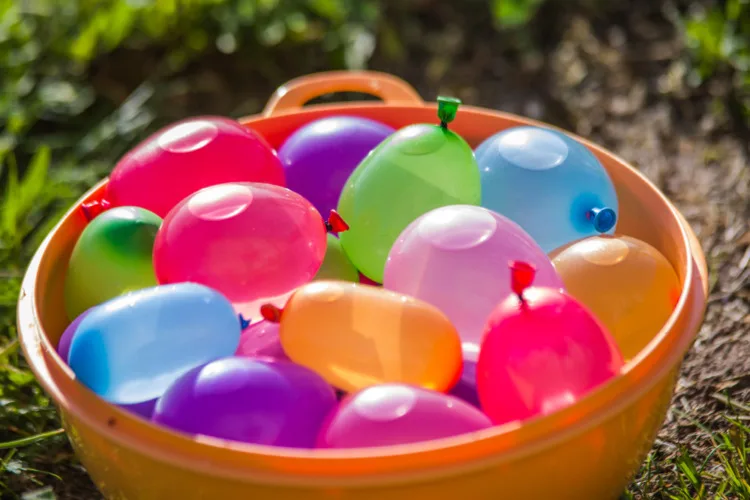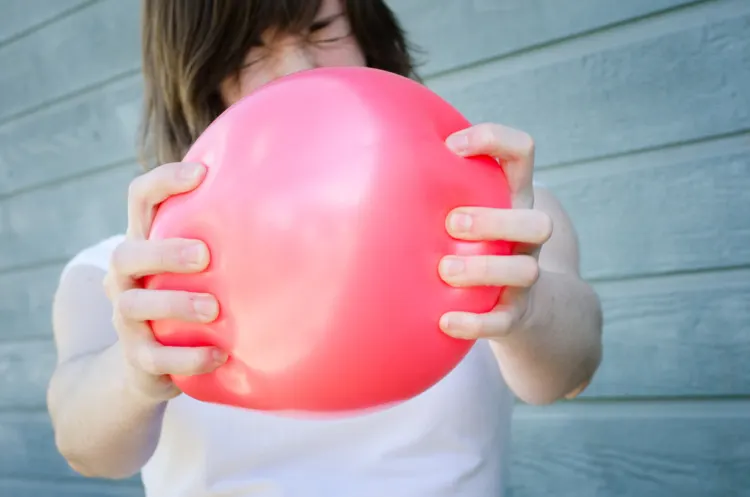The environmental impact of balloons, even biodegradable ones, are severe and little known by the general public. If people understood the environmental impact of balloons, they would think twice about buying them.
People ask, “where can I buy biodegradable balloons?” because they want to be environmentally conscientious, but these balloons are bad for the environment too.
This article will cover how balloons are bad for the environment, the damage they cause, and what you can celebrate your birthday party with instead of balloons!
So, Are Biodegradable Balloons Bad for the Environment?
Yes! Despite what the manufacturers want you to think, balloons plague the environment.
The manufacturers of balloons make it seem like they will disintegrate in a day or so after you use them, but this could not be farther from the truth.
Keep reading to learn more about these balloon problems.
What Are These Balloons?

So, what exactly are these so-called environmentally-friendly balloons? What are biodegradable balloons made of? Most balloons are natural latex that can decompose over time. Latex is essentially tough tree sap.
Most balloon companies use Hevea Brasiliensis latex, a tree that grows in warmer climates.
So, environmental balloons use natural, safe materials, however, the shape, construction, and longevity are the real problems.
Biodegradable Balloons Vs. Traditional Balloons

Since we’ve established latex balloons are bad for the environment, what about traditional latex balloons? As it turns out, balloons labeled biodegradable are not very different from traditional ones.
Biodegradable balloon manufacturers make slight changes, such as using more biodegradable strings and balloon weights. However, the latex used in each type of balloon is practically identical, showing how the biodegradable balloon industry’ claims are flimsy and untrustworthy.
See Related: Are Humans Animals? 15 Things to Know
Foil Balloons Vs. Latex Balloons

You may be asking yourself why not just use traditional foil balloons if the latex ones, labeled biodegradable or not, are a no-go. Well, foil balloons are exponentially worse. The claims that balloons are biodegradable are not necessarily false but are presented dishonestly.
After a very, very long time, balloons will oxidize and decompose. But foil balloons are not biodegradable by any stretch of the imagination. A foil balloon will outlive all of us given the chance.
They can be recycled, but if they wind up in the environment, they’ll exist forever. So, while we are here to explain how horrible latex and biodegradable balloons are, foil balloons, including vinyl, nylon, and mylar balloons, are the true enemy.
Why Are Balloons Bad for the Environment?

Your latex balloon will not decompose quickly, but does that necessarily mean it’s harmful to the environment? Yes, and we’ll help you understand why. Below are the top reasons why balloons are bad for the environment:
- Balloons Pollution: Balloon pollution is a grave problem, as balloons blow miles away and end up in once pristine places. Not only is balloon litter ugly and sad, but they contribute to the plastic pollution problem in our oceans, affecting us, marine life, and land wildlife.
- Animal Harm: Animal harm is easily the most tragic effect of balloons on the environment. Animals often mistake bright-colored balloons for edible foliage and flowers or maybe curious. They can ingest the balloons, blocking their intestines and eventually killing them. Or they can become tangled in the balloon string, causing injury or death.
- Power Outages: If you’ve ever seen balloons wrap around power lines, it may seem like no big deal, but balloons are a common cause of power outages. Power outages may seem like a mild inconvenience, but have drastic effects. For example, a power outage at a hospital is a dire situation.
- Electrical Fires: Along with outages, balloons caught on power lines or electrical boxes can start fires, potentially harming humans, animals, and vegetation.
- Waste of Helium: Lastly, helium is a non-renewable resource, and using it to fill balloons is a waste. We need helium to power much more important things, like MRI scanners, fiber optics, and LCD screens.
See Related: Are Greenhouses Bad for the Environment?
How Many Animals Are Killed by Balloons?
Unfortunately, it’s impossible to find solid numbers on how many animals are killed by balloons, as many die without being found.
However, environmental scientists estimate that more than 100,000 marine animals die, specifically birds, due to balloon pollution every year, whether plastic entanglement or balloon ingestion. And that figure does not include land wildlife harmed by balloons.
Are Helium-Filled Balloons Dangerous?

Many people think the helium in balloons pollutes the air, but it doesn’t. Helium is the second most abundant gas in the atmosphere, so it’s perfectly safe.
However, helium-filled balloons are extra dangerous because the helium carries the balloons for miles, polluting more places and making it harder to control balloon pollution.
And remember, running out of helium will be a problem for humanity, so balloons are a pitiful use for this non-renewable gas.
How Long Do Biodegradable Balloons Take to Decompose?

Now, for the question you’ve probably been waiting for. How long does it take for a latex balloon to disintegrate?
A decomposed balloon can’t harm any wildlife or power lines, so they’re safe once they decompose, right? Right! But balloons take six months to six years to completely disintegrate, giving them plenty of time to wreak havoc on nature.
As you can see, claiming that balloons are biodegradable is technically the truth, but saying they’re environmentally friendly is a bald-faced lie.
How Do Latex Balloons Decompose?
Latex balloons, because they’re a natural wood byproduct, decompose in the same way and at the same rate as wood fibers. The balloons can break down in two ways: biodegradation and photodegradation.
The Process to Biodegrade Balloons
Biodegradation breaks materials down via microorganisms, bacteria, and fungi, so they decompose into the land. It’s the natural version of composting. Many factors have to be just right for biodegradation to be complete.
For example, a balloon may land in a spot with plenty of fungi to break it down, but if the wind blows the balloon away, the process pauses. The specific circumstances required for biodegradation are why it can take years for latex balloons to decompose.
The Process to Photodegrade Balloons
Photodegradation is when light decomposes a material. The combination of sunlight and air on a latex balloon causes oxidation and hydrolysis, breaking down the balloon material.
Balloon Releases: Legality, Dangers, and More

Is releasing balloons bad for the environment? Absolutely. Is it legal? Less so every day. Balloon releases have substantial environmental impacts, especially massive balloon releases for parades and large celebrations.
A child accidentally letting go of their birthday balloon is not ideal, but a city or town releasing hundreds of balloons at once is a catastrophe. And many state governments are taking steps to stop this. Balloon releases are now banned in the following states:
- California
- Connecticut
- Florida
- Tennessee
- Maine
- Maryland
- Virginia
Unfortunately, this means the 43 other states still allow balloon release, so the problem with balloon debris persists. Understanding how and why releasing balloons is bad for the environment is a significant obstacle in this type of legislation, as many officials don’t know how dangerous it is.
The balloon release legislation stipulates:
- The number of balloons that can be released
- They can only be released indoors
- Science or government experiments are exempt
- Violations will be penalized
- What materials can be released
- Helium or lighter-than-air gas balloons are prohibited
Balloon releases are likely the most dangerous use of balloons. As mentioned, one runaway balloon is bad, but 100 is an environmental nightmare.
Eco-Friendly Alternatives to Biodegradable Balloons

While bad for the environment, balloon releases are a light-hearted and fun party staple. So, how can you achieve the same whimsical feeling without hurting the planet? We rounded up a few eco-friendly alternatives for you to consider for your next event.
Bubbles: Bubbles are one of the most popular balloon alternatives, as they are mostly made of water and disappear quickly. To avoid plastic packaging and mild chemicals, you can use homemade bubbles, which are slightly safer and cheaper!
Floating Flowers: For many, the beauty of a balloon release is letting something go, like a cleansing. You can achieve the same feeling by letting natural flower blossoms go down a stream or river. Or you can just place them in a pond and watch them float away.
Kites: Kites are brilliant balloon alternatives because they fly high in the air like helium balloons, and come in even more artistic and beautiful designs. And if a kite does get away, it can’t travel nearly as far as in the sky as helium balloon and if it’s made of natural paper and wood it will disintegrate faster.
Flags: Waving little flags or a ribbon in a crowd or outdoor party can have the same floaty effect as releasing balloons and will make everyone feel closer as a community. Make flags using recycled materials to make the event extra eco-friendly.
Wish Paper: Wish paper is a biodegradable type of paper that can disintegrate in just a week or two and is less likely to cause outages, fires, or animal harm. You can write a message on them and then release them in the wind.
Related Resources:
- Biodegradable vs Compostable: What is the Difference?
- Is Cardboard Biodegradable? 7 Things to Know
- Best Biodegradable Glitter for Candles


